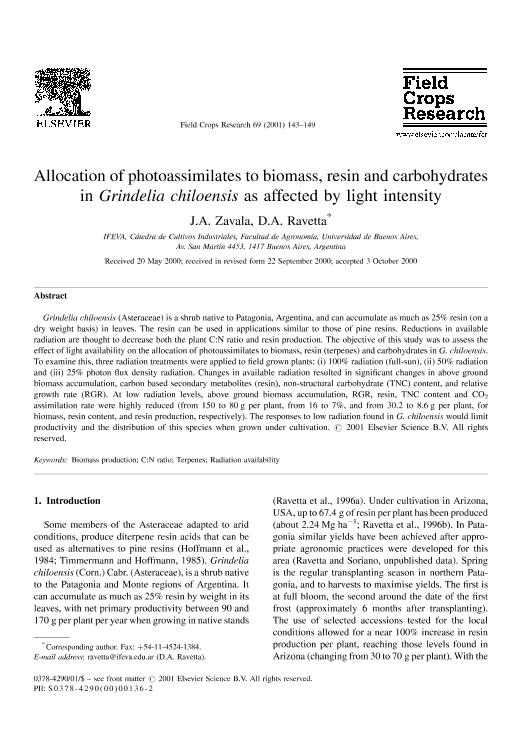Artículo
Allocation of photoassimilates to biomass, resin and carbohydrates in Grindelia chiloensis as affected by light intensity
Fecha de publicación:
03/2001
Editorial:
Elsevier Science
Revista:
Field Crops Research
ISSN:
0378-4290
Idioma:
Inglés
Tipo de recurso:
Artículo publicado
Clasificación temática:
Resumen
Grindelia chiloensis (Asteraceae) is a shrub native to Patagonia, Argentina, and can accumulate as much as 25% resin (on a dry weight basis) in leaves. The resin can be used in applications similar to those of pine resins. Reductions in available radiation are thought to decrease both the plant C:N ratio and resin production. The objective of this study was to assess the effect of light availability on the allocation of photoassimilates to biomass, resin (terpenes) and carbohydrates in G. chiloensis. To examine this, three radiation treatments were applied to field grown plants: (i) 100% radiation (full-sun), (ii) 50% radiation and (iii) 25% photon flux density radiation. Changes in available radiation resulted in significant changes in above ground biomass accumulation, carbon based secondary metabolites (resin), non-structural carbohydrate (TNC) content, and relative growth rate (RGR). At low radiation levels, above ground biomass accumulation, RGR, resin, TNC content and CO2 assimilation rate were highly reduced (from 150 to 80 g per plant, from 16 to 7%, and from 30.2 to 8.6 g per plant, for biomass, resin content, and resin production, respectively). The responses to low radiation found in G. chiloensis would limit productivity and the distribution of this species when grown under cultivation. © 2001 Elsevier Science B.V.
Palabras clave:
Biomass Production
,
C:N Ratio
,
Radiation Availability
,
Terpenes
Archivos asociados
Licencia
Identificadores
Colecciones
Articulos(SEDE CENTRAL)
Articulos de SEDE CENTRAL
Articulos de SEDE CENTRAL
Citación
Zavala, Jorge Alberto; Ravetta, Damián Andrés; Allocation of photoassimilates to biomass, resin and carbohydrates in Grindelia chiloensis as affected by light intensity; Elsevier Science; Field Crops Research; 69; 2; 3-2001; 143-149
Compartir
Altmétricas




